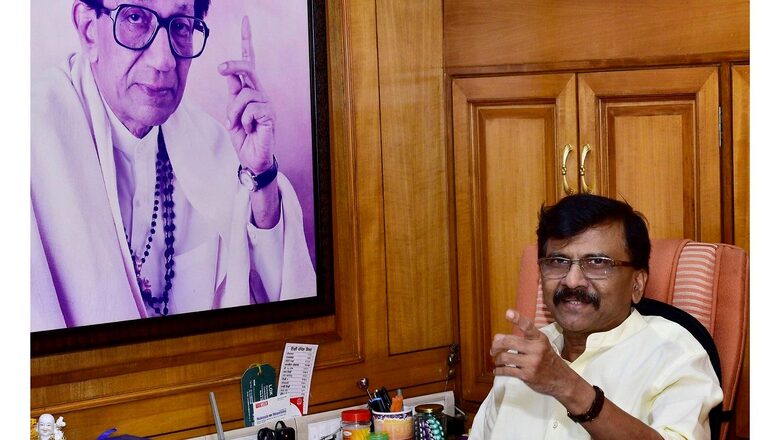
views
“Jab Balasaheb (Saamana mein) sampadkiya likhte the, tab log use seriously lete the… aur wo pramanik hota tha. Lekin unke baad hum Uddhav Thackeray aur doosre bade netaaon ke bayan TV par sunte hain aur usse party line ka pata chalta hai. Lekin kai baar usmein aur Saamana mein chhape sampadkiya mein gap dikhta hai…"
(When Balasaheb used to write editorials, all used to take it very seriously. But nowadays, we see on TV what Uddhav Thackeray and other top leaders say and understand what the party wants to say. Many a times, I have noticed a gap between what the party says and what the Saamana editorial is all about…)
These words of Rajesh Waghe, a sales coordinator in Mumbai, perhaps, sum up the mood among the avid readers of Saamana, the Shiv Sena’s mouthpiece. Waghe is a proud Shiv Sainik, with roots in the Sena’s bastion of Konkan. Without mincing his words, he says, “During 2019, even when back-channel talks were happening between the Shiv Sena and BJP, the Saamana editorials were criticising the state BJP leadership, which ultimately resulted in the break-up." He further adds, “I had heard in the news that many Shiv Sena leaders wanted to have the alliance with the BJP."
WORDS OF BAL THACKERAY to RAUT’s SAAMANA
Saamana, the mouthpiece of the Shiv Sena, is known for being unambiguous in its messaging. The words in Saamana have been central to the party’s communication. It began in 1988, as a tool of politics, when Bal Thackeray, then Shiv Sena supremo, himself a cartoonist, started writing editorials against the then Congress government, criticising their policies. He also published Marmik, a weekly magazine. Both, the newspaper and the magazine, tapped into the anti-establishment sentiment and highlighted the plight of the Marathi manoos, who was being allegedly cheated by the business class. Initially, Sena tapped into the anti-South Indian sentiment. Gradually, under Raj Thackeray, Shiv Sena supremo Thackeray’s more flamboyant nephew, it turned its gaze against the North Indians. In all this, Maharashtrians remained the centre of Shiv Sena’s politics, while Saamana provided the ideological mooring the party’s followers needed.
Saamana became the word of Bal Thackeray.
Anurag Chaturvedi, former editor of the Hamara Mahanagar, tells News18, “It’s been 35 years now that Saamana was launched. But I am of the opinion that till today Saamana has not matured to be considered a newspaper. During Balasaheb’s regime, they used to have balanced editorials and news coverage. But post Balasaheb, editorials are basically written with focus on criticising Narendra Modi. It’s Executive Editor Sanjay Raut has been rewarded with a Rajya Sabha seat for writing against the Bharatiya Janata Party (BJP), especially Modi. Today’s Saamana looks more like Sanjay Raut’s Saamana."
This criticism is emanating not just from the readers, but also political opponents and allies of the Shiv Sena. The present-day Saamana isn’t a reflection of the party supremo’s mind, but its editor’s, they say.
#BreakingNews | Sanjay Raut: EC has not given such decision for any party which they had given for #ShivSena. Was Election commissioner appointed or was brought in the haste just to deliver such order? | @mayuganapatye@mihirz @anjalipandey06 @anany_b pic.twitter.com/pd2HaPelta— News18 (@CNNnews18) February 21, 2023
DISTANCING FROM EDITORIALS
There have been a few instances when Saamana’s editorials have gone against the party line, leaving no option for the party, but to distance itself from it.
On May 1, 2014, the Saamana editorial slammed the Gujarati community, which led to an unprecedented distancing in the same paper the next day. Shiv Sena president Uddhav Thackeray, who was then holidaying abroad, had to issue a statement clarifying that he did not subscribe to the views. This was perhaps the first time that the Sena, the party, took a stand contrary to the Saamana editorial.
In another instance, Raut’s weekly column seemed to attack the system, when Sanjay Dutt was released from jail during the BJP-Sena tenure. The article had left Bal Thackeray furious.
When Raj Thackeray criticised Bollywood superstar Amitabh Bachchan, Saamana followed it up with a news item, which advised the star to learn loyalty from Rajnikanth, the South superstar. The Thackerays (Bal Thackeray and Uddhav) stood firmly behind the Bachchans during the controversy, disapproved of what was printed, and distanced themselves from the news item.
Sanjay Raut, Shiv Sena MP and the present editor of the mouthpiece, reiterates that Saamana is an independent newspaper. He says, “I have been associated with the Saamana for the past 35 years, back then there was no association with the BJP. In Saamana, we always write what our party line is. So, these allegations that Saamana is the reason for the rift between the BJP and Shiv Sena are wrong. Let them say whatever they want as truth is always bitter."
हे नाते खुप जुने आहे.ये रिश्ता बहोत पुराना है..साहेब..विनम्र अभिवादन !जय महाराष्ट्र! pic.twitter.com/vDhofuiVbi— Sanjay Raut (@rautsanjay61) November 17, 2022
THE 2019 FIRE
Did the Saamana or its editorials add fuel to the fire as communication broke down between the two old allies in 2019? Sources say that several party leaders had advised Uddhav that the language of the editorials should be less combative. The Maharashtra BJP leadership, the pre-poll alliance partner of the Shiv Sena, too, had urged Uddhav on multiple occasions between 2014 and 2019 that Saamana editorials must stop targeting the BJP leadership.
In 2019, post the Assembly elections, when the BJP emerged as the single largest party, the Saamana editorial claimed that there was an understanding between Uddhav Thackeray and Amit Shah, then BJP president, on the power-sharing formula and it was arrived at when the latter had visited Thackeray residence Matoshree. Devendra Fadnavis denied it later.
Since then Saamana took a strident stand against the BJP and went all out in its criticism. In 2014, too, when the BJP had snapped its alliance with the Shiv Sena, Saamana had attacked its NDA partner. Initially, Saamana was focused on the Hindutva ideology and nationalism, but later views on regionalism became more pronounced, which suited the Nationalist Congress Party (NCP) and Congress, Shiv Sena’s new found allies, more.
“Balasaheb Thackeray was more open to talks and enjoyed good relations with the BJP leaders of his time. But the new, changed leadership of both the BJP and Shiv Sena failed to follow in their footsteps. Earlier, the BJP was content to play second fiddle to the Shiv Sena, while it played the role of the Big Brother. But the emergence of the Modi-Shah combine changed the dynamic of national politics. Maharashtra was no exception and saw a realignment too. Uddhav Thackeray failed to cope up with the new emerging equations and perhaps secretly decided to pursue a different path to fulfil his long-pending dream of becoming the Chief Minister of Maharashtra. But it seems to have come at a steep cost. He has lost not just power, but his MPs and MLAs have defected, the Election Commission (EC), in a ruling, has ordered both the party name and the ‘bow and arrow’ symbol to be handed over to Eknath Shinde, leaving Uddhav Thackeray with no option but to go to the people’s court. He could either emerge a leader or deliver a final blow to whatever is left of his party," says Sudhir Suryavanshi, author of the book Checkmate.
#Exclusive | "We are Balasaheb’s loyalists, never betrayed him like #EknathShinde. Shiv Sena is Thackeray and Thackeray is #ShivSena. EC has given this order to favour someone": @rautsanjay61 speaks with @mayuganapatye #MaharashtraPolitics #UddhavThackeray #ShivSenaCrisis pic.twitter.com/MFOcH85qLT— News18 (@CNNnews18) February 22, 2023
THE VIEWS THAT HURT
In the vicinity of Shiv Sena Bhavan, we met Rajendra Chandorkar, a retired clerk of the Brihanmumbai Municipal Corporation (BMC) and a staunch Sena loyalist. “Mujhe nahin pata tha ki Air India aur Reserve Bank of India ke headquarters ko Delhi shift karne ka kuch plan hai. Ek din Saamana mein maine ye padha. Lekin Shiv Sena ne Mumbai mein jabardast andolan kiya aur Centre ne unka plan cancel kiya." He further added, “Saamana nahi hota to Centre ke khilaf doosra kaun khabar dikhata?"
(I didn’t know of the plan to shift the headquarters of Air India and Reserve Bank of India to Delhi. I read it in Saamana. But the Shiv Sena agitated in Mumbai and the Centre had to cancel its plan. Other than Saamana, who would have dared to publish news against the Centre?)
The Shiv Sena also publishes a Hindi newspaper called ‘Dupahar ka Saamana’. It reproduces the Marathi editorials in Hindi and is aimed to attract non-Marathis, especially Hindi-speaking people from North India. Rajesh Mishra, a local tea vendor, near Mogal lane in Dadar, has keen interest in Maharashtra politics. He speaks Marathi, but is not fluent in the language, and gets all his updates on the Shiv Sena and its politics from the Hindi Saamana. Mishra says, “Saheb main Hindi Saamana aaj bhi padhta hoon lekin sampadkiya padhna chhod diya. Sampadkiya kai baar editor ke khud ka vichar lagta hain, na ki party ka. Shivaji Park mein main pichle 15 saal se chai bechta hoon. Kai log kahte hain ki 2019 ke baad Saamana ke sampadkiya ne NCP aur Congress ke khilaf kabhi kuch jyada bola nahi. Kabhi kabhi to aisa lagta hain ki kya Saamana unka paper hai?
(I do read Hindi Saamana. But I have stopped reading editorials as I feel it is more of the editor’s personal view compared to that of the party’s. I have been selling tea in Shivaji Park for the past 15 years and I hear a lot of people say that after 2019, the editorials in Saamana haven’t said much about the NCP and Congress. Sometimes it feels is Saamana still their mouthpiece?)
Senior journalist and political analyst Prakash Akolkar, also author of Jay Maharashtra, a book on Shiv Sena, says, “Due to political compulsions, Uddhav Thackeray couldn’t speak on political issues, so he used Saamana to give a political line to his party workers. But it has backfired. Raut paid the price for writing against the BJP and Modi. He had to face ED heat. There is no doubt that the rift between the BJP and Shiv Sena increased due to Saamana. The tone and tenor of its editorials hurt the BJP leaders."
Political parties have often used in-house publications as mouthpieces to communicate the party’s programmes and policies and shape political narrative. They are often direct in their import and messaging as their primary objective is to rally the core constituency. From the Communist party that used its mouthpiece to communicate Prakash Karat’s views on the Nuclear deal, to the BJP’s Kamal Sandesh, parties with strong ideological positioning routinely use the written word as a tool to further their political agenda. But when the tool begins to shape destruction and starts leading to differences, then it is important to revisit the thrust of its editorial underpinning. Haven’t we often heard that newsrooms need to constantly evolve?
It may not be entirely out of line to expect the editor(s) of Saamana to evaluate the damage their belligerence may have caused to the fortunes of Uddhav Thackeray’s Shiv Sena.
Read all the Latest Politics News here



















Comments
0 comment